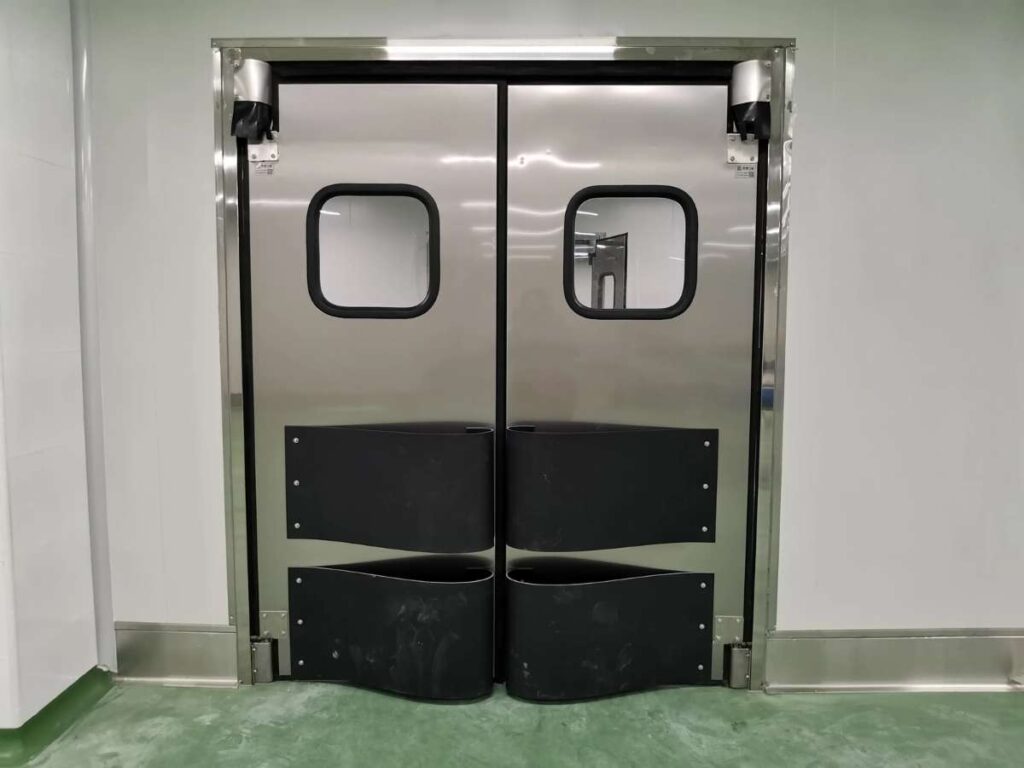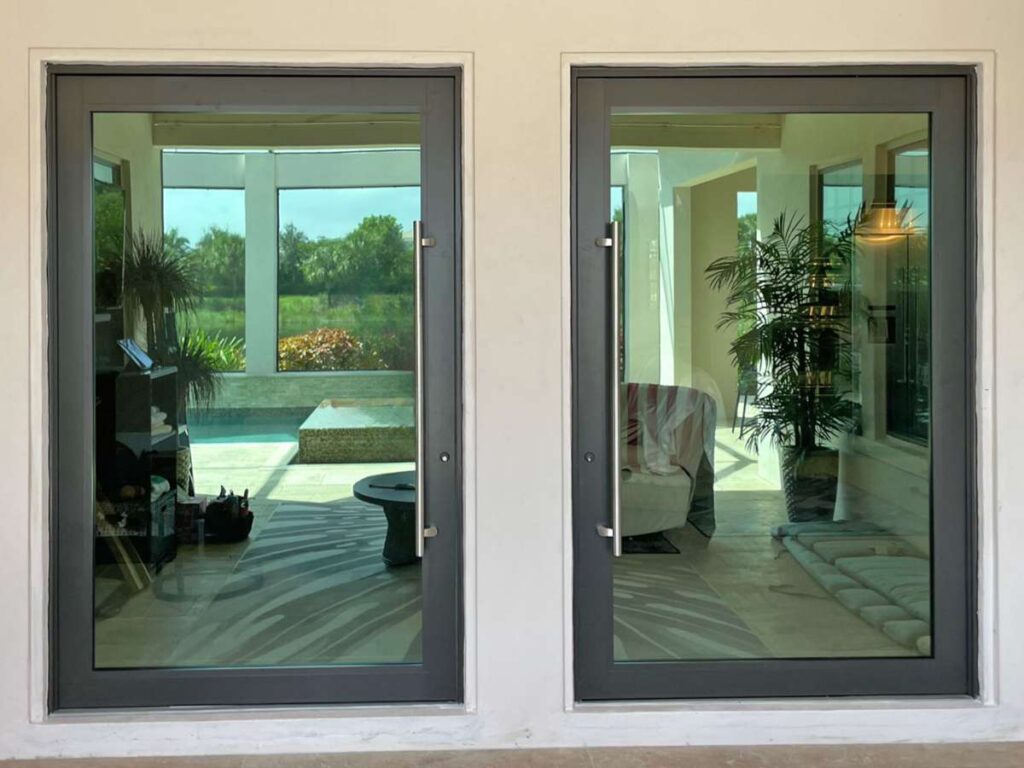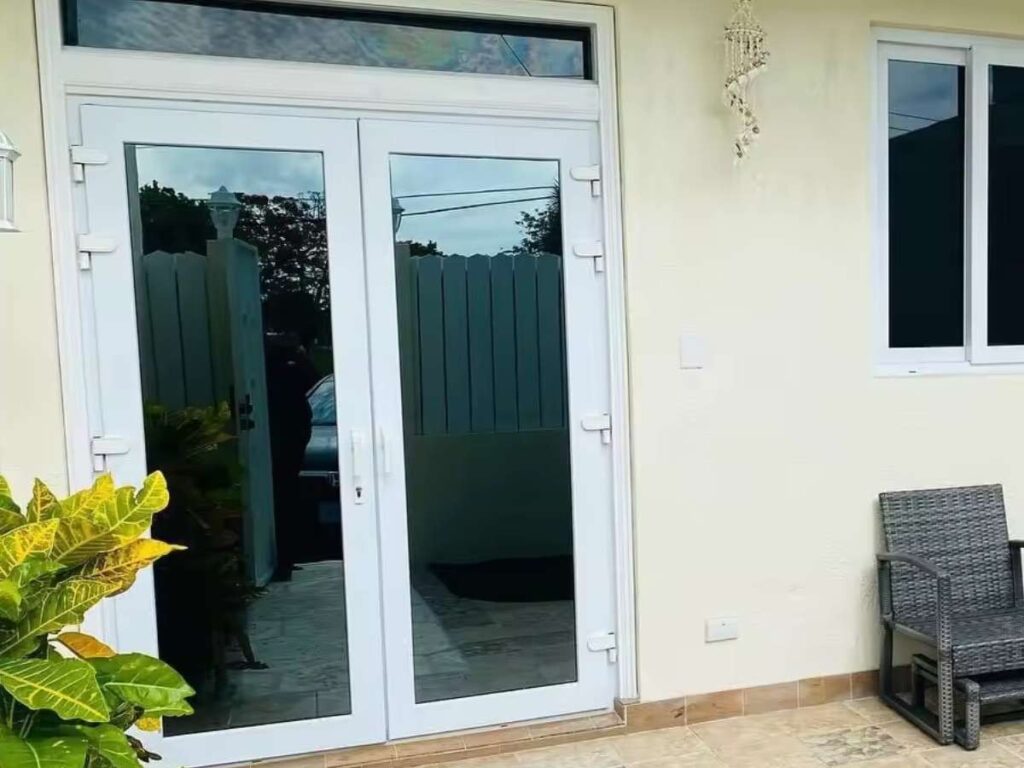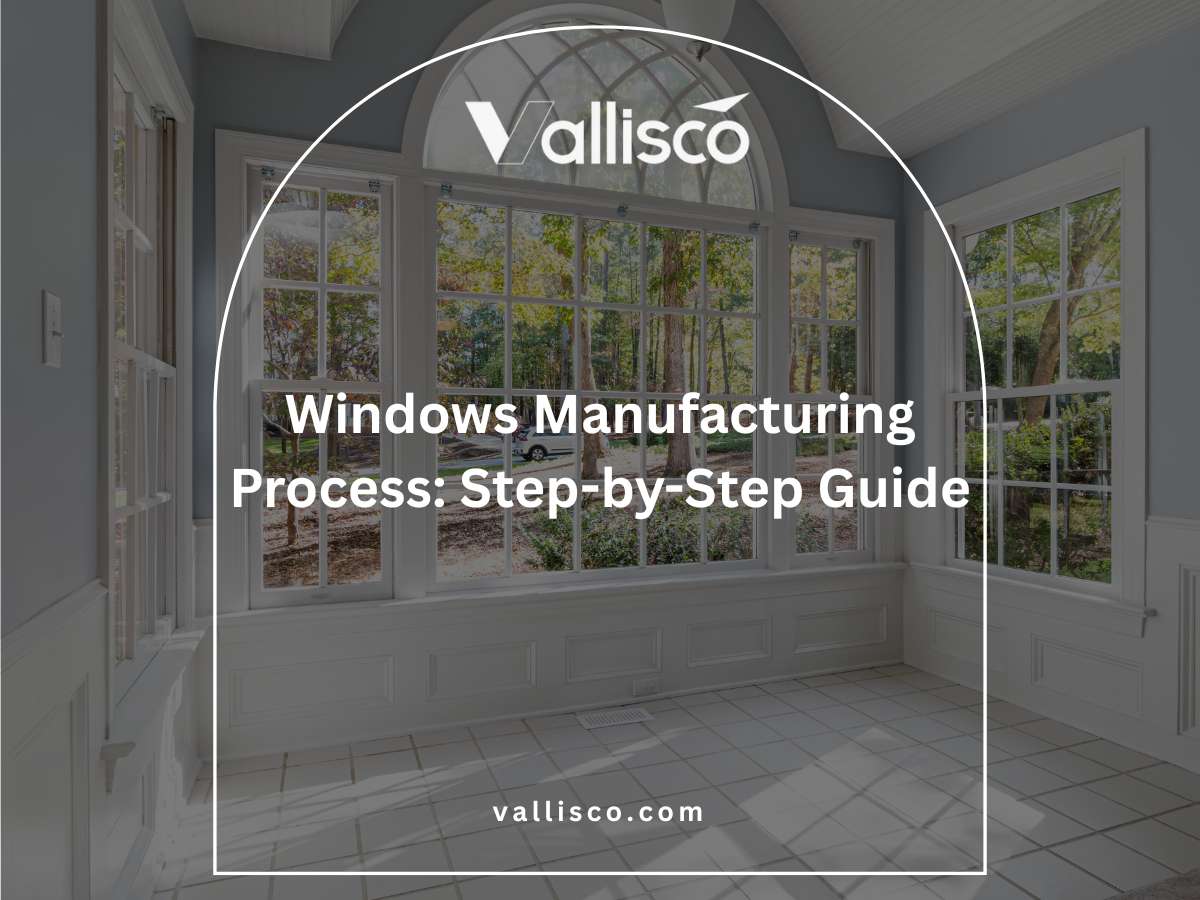I once met a villa owner who told me he replaced his storage doors three times in two years before finding the right impact doors. The stress and cost taught him that not all doors are made for constant use.
Maybe you’ve faced the same problem in your own business. That’s why choosing carefully matters.
I work directly with hotel managers, greenhouse operators, and contractors. I’ve guided them through picking doors that last, and I bring that same knowledge here.
This guide will explain what commercial impact doors are, how they perform, where they’re most useful, and what to check before buying. You’ll find the answers you came for, in clear steps.
Think of this as advice from someone who has seen the difference first-hand.
Let’s get started!
1. What Are Commercial Impact Doors?
I’ve seen many businesses struggle with regular doors that just can’t handle the pressure of daily work. That’s where commercial impact doors come in. These are heavy-duty doors built for high-traffic areas. They swing both ways, so staff can move quickly without stopping. They’re made to take hits from carts, luggage, or equipment without breaking down.
Here’s what makes them different from standard doors:
- Double-Acting Swing: Opens both directions for smooth movement.
- Durable Materials: Steel, aluminum, plastic, or PVC.
- Impact Resistance: Designed to handle carts, trolleys, or foot traffic.
- Safety Features: Vision panels or bumpers to prevent accidents.
- Easy to Clean: Smooth surfaces for hygiene in food service or healthcare.
When you choose impact doors, you’re choosing something that keeps up with your business pace. They’re not just about access; they’re about safety, efficiency, and making your team’s work easier.

2. Benefits of Installing Commercial Impact Doors
From what I’ve seen working with hotels, warehouses, and villas, the right doors do more than just open and close. They make work safer, faster, and more reliable. If you’re considering commercial impact doors, here are the real benefits you’ll notice in daily use:
- Durability That Lasts: These doors are built with strong materials like steel or reinforced plastics. They hold up against constant bumps and movement, which means fewer repairs and replacements for your business.
- Better Safety for Staff and Guests: Vision panels and bumpers reduce accidents in busy spaces. Your team can see what’s coming, and equipment is less likely to cause damage when moving through the doorway.
- Smoother Workflow: Impact doors swing both ways, so staff don’t have to stop or struggle with handles. In fast-paced settings like kitchens, warehouses, or greenhouses, that ease makes a big difference in efficiency.
- Noise and Temperature Control: Many impact doors help keep areas quieter and more stable in temperature. For example, cold storage stays cold, and guests in hotels aren’t disturbed by kitchen noise.
- Cost Savings Over Time: Because these doors are built to last, you won’t spend as much on constant replacements. Investing in them upfront pays off through fewer breakdowns and lower long-term costs.
3. Types of Commercial Impact Doors
Over the years, I’ve seen that no two businesses use their doors in the same way. A resort doesn’t have the same needs as a warehouse, and a greenhouse won’t use the same setup as a restaurant. That’s why knowing the types of commercial impact doors can help you match the right option to your work environment.
Below, I’ll walk you through the most common types I recommend to clients:
Stainless Steel Impact Doors
Stainless steel impact doors are the strongest option available. They are made for industrial settings where heavy carts, forklifts, or constant movement put pressure on every entry point. These doors resist corrosion, dents, and scratches, making them a good fit for warehouses, factories, and food-processing plants.
If your business handles harsh cleaning chemicals or has strict hygiene requirements, stainless steel holds up well and stays easy to sanitize. You’ll find them heavier than other options, but they also offer unmatched toughness for long-term use.

Aluminum Impact Doors
Aluminum impact doors strike a balance between strength and lighter weight. They are often chosen for hotels, resorts, and commercial kitchens where daily movement is high but not as heavy as a warehouse.
Aluminum is resistant to rust and moisture, which makes it reliable in humid environments like greenhouses or seaside properties. These doors are easier to swing than stainless steel, so staff move faster without effort. They may not handle as much heavy equipment, but for hospitality or light commercial spaces, they are a practical choice.

PVC or Flexible Plastic Impact Doors
PVC impact doors are common in food storage, cold rooms, and supermarkets. They are lightweight, flexible, and provide good insulation for spaces where temperature control matters.
I often see businesses use them in areas where staff carry goods by hand, push carts, or move through frequently. Because the panels are clear or semi-clear, visibility is improved, which helps prevent accidents. They may not be as strong as metal doors, but for hygiene and energy savings, they’re an affordable and effective option.

Rubber Impact Doors
Rubber impact doors are tough and flexible at the same time. They absorb shocks well, making them useful in warehouses, agricultural facilities, or workshops. I’ve noticed they hold up in places where equipment constantly runs into them.
Rubber also works in environments with wide temperature changes since it won’t crack or warp easily. These doors aren’t as common in hotels or villas, but for greenhouses or industrial use, they can be the most practical option.

4. Key Features to Look For
I’ve helped many business owners choose impact doors, and I always remind them that details matter. The right features can make your doors safer, longer lasting, and easier to work with. If you’re thinking about investing, here are the main features you should pay attention to.
- Material Quality: Steel, aluminum, PVC, or rubber each serve different needs. Think about your building’s environment and daily traffic. A hotel kitchen doesn’t need the same strength as a warehouse, but both need materials that last.
- Vision Panels: Clear panels make a big difference in safety. They let staff see who or what is coming from the other side, which lowers the chance of accidents in busy hallways.
- Swing Action: Most impact doors are double-acting, meaning they swing both ways. This small detail speeds up workflow and saves staff time, especially in high-pressure areas like kitchens or loading docks.
- Insulation Options: If you manage cold rooms, greenhouses, or temperature-sensitive areas, insulation is key. Proper cores and seals will help keep air in, cut energy costs, and protect goods or crops.
- Protective Add-Ons: Bumpers, kick plates, and edge guards extend the life of the door. These are especially helpful if your space uses carts, trolleys, or equipment that often hits the door surface. Vallisco often includes these features to give their doors extra durability.
5. Best Applications by Industry
I’ve seen impact doors used in many different types of businesses, and each one benefits in a specific way. Knowing where these doors work best can help you picture how they might fit in your own building. Take a look at these common industries and the roles impact doors play in each:
| Industry | Application | Recommended Doors | Why It Works |
| Hotels & Resorts | Kitchens, staff entrances, storage rooms | Aluminum or PVC Impact Doors | Keeps staff moving quickly, reduces noise, and separates guest areas from service areas. |
| Greenhouses | Entry points, climate zones | PVC or Rubber Impact Doors | Helps control airflow, maintains temperature, and protects plants from outside conditions. |
| Warehouses | Loading docks, main aisles | Stainless Steel or Rubber Impact Doors | Handles forklifts and carts, reduces damage from collisions, and improves workflow. |
| Healthcare | Patient areas, supply rooms, labs | Stainless Steel or Aluminum Impact Doors | Maintains hygiene, allows smooth movement of equipment and stretchers, and reduces contamination risks. |
| Restaurants | Kitchen to dining areas, storage access | Aluminum or PVC Impact Doors | Swing doors keep service fast, cut noise, and separate food prep from guest areas. |
| Retail & Supermarkets | Cold rooms, stockrooms | PVC Impact Doors | Insulated doors reduce energy loss, withstand heavy traffic, and protect stored goods. |
Impact doors fit many industries because they balance safety, durability, and efficiency. By matching the right door to your business type, you get smoother operations and fewer long-term problems.
6. Installation & Maintenance Tips
I’ve noticed that even the best impact doors won’t perform well if they’re installed poorly or left without care. The good news is, both installation and maintenance are straightforward if you know what to watch out for. Here’s what I recommend to clients like you:
Installation Tips
- Hire Skilled Installers: A professional team makes sure the door fits correctly, swings smoothly, and seals as it should. It saves you from problems that show up later, like uneven wear or air leaks.
- Check Measurements Twice: Before ordering or fitting the door, confirm wall openings, clearance space, and swing direction. A small mistake here can cause delays and extra costs.
- Use the Right Hardware: Hinges, seals, and frames must match the door material. I’ve seen doors fail early because cheaper hardware was used during installation.
- Plan for Traffic Flow: Think about how staff, carts, or equipment will move through the doorway. Proper placement reduces accidents and keeps operations smooth.
Maintenance Tips
- Inspect Regularly: Set a simple schedule to check hinges, seals, and swing action. Small adjustments now can stop larger repairs later.
- Clean Surfaces Often: Impact doors in kitchens, healthcare, or greenhouses need regular cleaning. Smooth materials make this easy, and it prevents dirt or bacteria from building up.
- Repair Damage Early: Don’t wait on small cracks, scratches, or loose parts. Quick fixes protect the door’s strength and help it last longer.
- Lubricate Moving Parts: Hinges and pivots benefit from occasional oiling. This keeps the swing smooth and avoids stiffness over time.
- Replace Worn Seals: If your doors help with insulation, watch the seals. Replacing them when worn keeps energy use low and your rooms comfortable.
7. 4 Factors to Consider Before Buying Commercial Impact Doors
From what I’ve seen, many businesses rush into buying doors without weighing the most important factors. That often leads to higher costs and frustration later. If you’re planning your purchase, here are the key things you should think about before making a final decision:
Building Environment
The first thing I ask clients is where the doors will be used. A hotel kitchen has very different needs compared to a greenhouse or a warehouse. Think about humidity, temperature, and exposure to chemicals or cleaning agents.
If your building faces constant moisture, aluminum or PVC doors may perform better than steel. On the other hand, industrial facilities with forklifts and heavy traffic will need stainless steel or rubber. Matching your environment with the right door material is the foundation of a smart purchase.
Traffic Levels
You should also measure how much daily movement the door will handle. For example, resorts or restaurants see steady staff flow but not the same forceful impacts as loading docks. A warehouse, though, will push doors to the limit every day.
High-traffic areas call for reinforced materials and protective add-ons like bumpers or kick plates. Lighter-use spaces can balance durability with ease of swing, so staff don’t waste energy moving through. If you know your traffic levels, you’ll avoid buying doors that wear out too quickly.
Safety and Compliance
Many industries have rules you can’t overlook. In healthcare, hygiene standards mean smooth, easy-to-clean doors are non-negotiable. For warehouses or public buildings, fire ratings and accessibility may also apply.
I’ve worked with clients who had to replace newly installed doors simply because they didn’t meet code. That’s an expensive mistake. Always check local regulations and make sure your supplier provides documentation before you buy.
Long-Term Costs
Price is often the first thing people look at, but it shouldn’t be the only factor. A cheaper door may save you money upfront, but frequent repairs and replacements will cost far more over time. I’ve seen this happen again and again.
Think about the lifespan of the material, the ease of maintenance, and the energy savings from insulation features. When you spread those benefits across years of daily use, the right door often pays for itself. Trusted manufacturers like Vallisco design their doors with these long-term savings in mind.
Conclusion
The villa owner I mentioned earlier learned the hard way that choosing the wrong doors wastes money and time.
Once he switched to commercial impact doors, his staff moved faster and his property ran smoother. That lesson still holds true for hotels, greenhouses, warehouses, and more.
In this guide, you’ve seen the benefits, types, features, and factors that matter most.
Now it’s your turn to make a smarter choice for your building.
If you’re ready to find doors built for your business, Vallisco can help. Contact us today!
Learn More: Recommended Reads
Want to see more products? We’ve got plenty of options that might just be the perfect fit for you:
Still haven’t found what you’re looking for? Don’t hesitate to contact us. We’re available around the clock to assist you.







